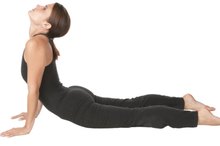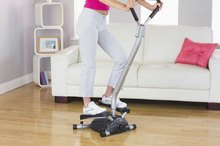Exercises for Pelvic Floor Tension & Spasms
The pelvic floor is made up of muscles. The small puborectalis, pubococcygeus and iliococcygeus muscles together are called the levator ani, which, along with the coccygeus muscle, forms the pelvic diaphragm.
If you are experiencing serious medical symptoms, seek emergency treatment immediately.
They form a hammock of muscles at the bottom of the pelvis that support the bladder, uterus and rectum. Openings in the muscles allow these organs to connect with the outside of the body through the urethra, vagina and rectum.
Locating and Feeling the Pelvic Muscles
Women should concentrate on identifying the muscles by trying to interrupt the flow when urinating. Visualize lifting the pelvic floor muscles and tightening them.
When you can successfully stop and start the urine flow repeatedly you are gaining conscious control over the muscles of the pelvic floor. Men and women should practice tightening the rectal sphincter muscle. At first it may be difficult to feel the specific muscles you are exercising, but with practice you will be able to exercise the right muscles and you will feel them becoming stronger. Alternately contracting and relaxing the muscles will help to reduce muscle spasms.
- Women should concentrate on identifying the muscles by trying to interrupt the flow when urinating.
- When you can successfully stop and start the urine flow repeatedly you are gaining conscious control over the muscles of the pelvic floor.
Levator Ani Syndrome
Breathing Exercises for Sleep Apnea
Learn More
Levator ani syndrome refers to chronic pain in the muscles of the pelvic floor, due to muscle spasms.
Mind/body techniques such as breathing exercises and yoga can be very helpful for pelvic pain that is muscular in origin, according to the University of California School of Medicine. Since the spasm is often due to stress, learning to reduce stress with breathing exercises makes sense.
Breathing Exercise
Lie down comfortably with a small pillow under your knees. Place your hands over the bottom of your ribs, fingertips touching.
Inhale slowly until you feel your ribs expanding. Hold the breath for one second and then slowly exhale. This trains you to fill your lungs completely with each breath, and then empty them completely as well. Practice for five minutes. Focus on how your breathing feels and when other thoughts come up, let them go and go back to focusing on your breath.
- Lie down comfortably with a small pillow under your knees.
Stretching Exercises
Breathing Exercises for Constipation
Learn More
Yoga exercises will help you gradually stretch and relax pelvic floor muscles. Basic yoga poses like the bridge pose, bow pose, locust pose and cobra pose stretch the muscles surrounding the lower abdomen. Add stretches for the inner thigh and hamstrings to complete the session. Learning from a yoga instructor will help you do the poses correctly. Then make a habit of daily practice, even after your symptoms reduce and you feel better. The bow pose is difficult; don't attempt it until your yoga teacher feels you are flexible enough to avoid straining your joints and muscles.
- Yoga exercises will help you gradually stretch and relax pelvic floor muscles.
- The bow pose is difficult; don't attempt it until your yoga teacher feels you are flexible enough to avoid straining your joints and muscles.
Cobra Pose
Lie down on the floor, face down.
Place your hands beneath your shoulders, with your elbows close to your sides.
Inhale as you press your hands down and lift your chest off the floor.
Extend your head and neck upward, stretching the front of your chest and abdomen. Exhale as you return to the beginning position.
- Lie down on the floor, face down.
- Inhale as you press your hands down and lift your chest off the floor.
Bridge Pose
Lie on your back with your knees bent, feet together. Keep your arms on your side, palms on the floor. Inhale as you lift the hips towards the ceiling, keeping your feet and palms flat on the floor.
Hold this position while you stretch your arms overhead. Exhale as you return to the starting position.
- Lie on your back with your knees bent, feet together.
- Inhale as you lift the hips towards the ceiling, keeping your feet and palms flat on the floor.
Locust Pose
Lie on the floor face down with your arms along the sides of your torso, palms up, forehead resting on the floor. Turn your big toes toward each other and tighten your buttocks so your coccyx presses toward your pubis. Lift your head, shoulders, arms and legs off the floor, so your body is resting on your abdomen and lower ribs.
Stretch your arms back toward your feet, keep legs and buttocks tense, and hold this position for 30 seconds. Breath slowly in and out while holding the pose, and release the position with an exhalation.
- Lie on the floor face down with your arms along the sides of your torso, palms up, forehead resting on the floor.
- Stretch your arms back toward your feet, keep legs and buttocks tense, and hold this position for 30 seconds.
Bow Pose
Begin face down as in the locust pose.
Bend your knees to bring your heels close to your buttocks. Reach back and grasp your ankles with your hands, keeping your knees close together.
Inhale and push your legs away from your buttocks, keeping your hands on the ankles, to pull your head, shoulders and upper torso off the floor. Avoid a rocking motion. Hold the pose for 30 seconds and release on an exhalation.
- Begin face down as in the locust pose.
- Inhale and push your legs away from your buttocks, keeping your hands on the ankles, to pull your head, shoulders and upper torso off the floor.
Related Articles
References
- Kloubec J. Pilates: how does it work and who needs it? Muscles Ligaments Tendons J. 2011;1(2):61-66.
- Marques A, Stothers L, Macnab A. The status of pelvic floor muscle training for women. Can Urol Assoc J. 2010;4(6):419-424.
- Pedriali FR, Gomes CS, Soares L, et al. Is pilates as effective as conventional pelvic floor muscle exercises in the conservative treatment of post-prostatectomy urinary incontinence? A randomised controlled trial. Neurourol Urodyn. 2016;35(5):615-21. doi:10.1002/nau.22761
- Pelvic floor training. InformedHealth.org. Cologne, Germany: Institute for Quality and Efficiency in Health Care (IQWiG). Updated December 30, 2016.
- Kegel Exercises: How to Strengthen Pelvic Floor Muscles, Staff Writers, mayoclinic.com
- Pelvic Floor Health. Strengthening Your Core, Carrie Levine, CNM, MSN, womentowomen.com
Writer Bio
Ramona French owned a massage school and taught massage for 28 years. In that time she wrote textbooks on Swedish, acupressure, deep tissue and lymph drainage massage. She is the author of "Introduction to Lymph Drainage Massage" and "Milady's Guide to Lymph Drainage Massage." Her book, "The Complete Guide to Lymph Drainage Massage," published by Milady, was released in October 2011.








